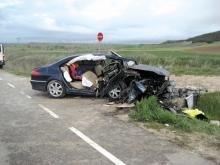The latest official data from the European Transport SafetyCommission (ETSC) shows that young people are amongst those facing the highest fatality risks while on the road
in Europe. Some 140,000 young people aged 15-30 have lost their lives on Europe’s roads since 2001. Of these, 9,150 died in 2010. While this age group represents 20% of the population of the EU, the same
group accounts for 30% of the total number of road deaths.
The latest official data from the European Transport Safety Commission (ETSC) shows that young people are amongst those facing the highest fatality risks while on the road in Europe.
Some 140,000 young people aged 15-30 have lost their lives on Europe’s roads since 2001. Of these, 9,150 died in 2010. While this age group represents 20% of the population of the EU, the same group accounts for 30% of the total number of road deaths.
Mortality of young people, the number of deaths divided by population, is 69% higher than the corresponding figure for people of all other ages. The latest Road Safety Performance Index (PIN) Flash also reveals that young males are a particularly problematic group, making up 81% of the number of young people killed on EU roads.
Portugal, Latvia and Spain have achieved the greatest success
in reducing the number of young people killed in road accidents, while good progress has also been made in Sweden, The Netherlands and Switzerland. These last three countries now have the safest roads in Europe for young people. Overall, the number of fatalities in traffic accidents in Spain for instance has dropped by more than 50% between 2001 and 2010 from 5,517 to 2,478. In total, the 10 years saw 41,665 people lose their lives on Spanish roads while 205,774 were seriously injured.
5201 Stop Accidentes, a road safety association, has asked the Spanish Government to maintain its commitment to keeping road safety a priority and to complete the Strategic Road Safety Plan 2011-2020 which had been on the previous administration’s agenda. This aims to reduce road traffic accident fatalities by almost 40% by 2020, from the 59 deaths/million inhabitants at present to 37 deaths/million.
The plan also aims to reduce to zero the number of children who die without a child safety retention system, reduce by 30% the number of deaths from exiting conventional roads or accidents on the way to work, and reduce the number of drivers between 18 and 24 years old who die or are seriously injured at weekends.
Some 140,000 young people aged 15-30 have lost their lives on Europe’s roads since 2001. Of these, 9,150 died in 2010. While this age group represents 20% of the population of the EU, the same group accounts for 30% of the total number of road deaths.
Mortality of young people, the number of deaths divided by population, is 69% higher than the corresponding figure for people of all other ages. The latest Road Safety Performance Index (PIN) Flash also reveals that young males are a particularly problematic group, making up 81% of the number of young people killed on EU roads.
Portugal, Latvia and Spain have achieved the greatest success
in reducing the number of young people killed in road accidents, while good progress has also been made in Sweden, The Netherlands and Switzerland. These last three countries now have the safest roads in Europe for young people. Overall, the number of fatalities in traffic accidents in Spain for instance has dropped by more than 50% between 2001 and 2010 from 5,517 to 2,478. In total, the 10 years saw 41,665 people lose their lives on Spanish roads while 205,774 were seriously injured.
The plan also aims to reduce to zero the number of children who die without a child safety retention system, reduce by 30% the number of deaths from exiting conventional roads or accidents on the way to work, and reduce the number of drivers between 18 and 24 years old who die or are seriously injured at weekends.






